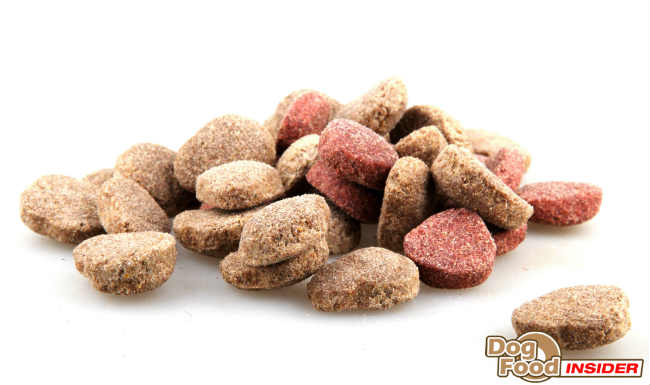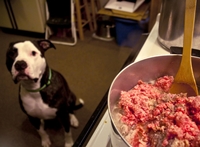
This post may contain affiliate links. We are compensated for referring customers to our affiliate partners.
Of course, there was lots of advice about feeding dogs long before there was commercial dog food. Perhaps not surprisingly, most of it was similar to what we know about feeding dogs today. For example, some owners were advised to give their dogs liver and heart from deer, along with milk, cheese, and bread (mixed with some blood from the deer). Beloved pets usually ate better than yard dogs.
Today we have come full circle and many owners like the idea of making their dogs’ meals instead of feeding them a commercial diet. There are a number of benefits of making your dog’s food.
Benefits of Making Your Dog’s Food
- You can personally select the ingredients in your dog’s food; this is helpful if your dog has allergies or if you want to make sure you use or avoid certain ingredients;
- You can choose the quality of the food you want to use – whether it’s food from a local farmer, market, grocery store, or from a bulk source; you can use organic, free-range, or other kinds of food that you want;
- If you buy ingredients in bulk you can often save money and making your dog’s food doesn’t have to cost any more than buying dog food; sometimes it can cost less while being more nutritious;
- You know how your dog’s food is prepared and can be assured there won’t be any dog food recalls;
- You can prepare foods in larger batches so you can freeze smaller portions for later use, thus saving time and effort;
- Making food for your dog is no more difficult than making food for yourself or your family but it is usually more nutritious than commercial dog food;
- Even the pickiest dog usually loves to eat food that you have prepared for him in your own kitchen;
- Other benefits include good skin, good breath, clean teeth, and less doggy odor. In addition, dogs usually have smaller, more compact stools. Dogs are more likely to be well-muscled and lean on a home-prepared diet, according to people who feed this kind of diet.
With all of these benefits you might be wondering why everyone doesn’t make their dog’s meals. Well, there are some downsides to consider.
Downside To Making Your Dog’s Meals
- Making your dog’s meals does take time. You have to allow time so you can shop for ingredients about once a week. You also need to allow time so you can prepare the food. Some people like to set aside one afternoon or evening per week (often on the weekend) so they can prepare their dog’s meals for the coming week.
- The cost of making your dog’s meals is up to you. If you can buy meats in bulk and freeze them, you can often save money. But if you buy your meats at your local store, the way you buy your own meat, then preparing meals for your dog can be expensive. If you have special requirements such as organic meats and vegetables, free-range chicken, or pasture-raised beef, for example, your costs will be even greater.
- There is no guarantee that your meats and produce will be entirely free of bacteria. You can use good sanitation in your kitchen, but even so, sometimes meats and produce are recalled because they have been contaminated before you buy them.
- When you make your dog’s meals it’s very important to make sure his diet is nutritionally balanced. In most cases a single meal will not be completely nutritionally balanced. This is not unusual for a person’s meals either. You probably don’t get all of your vitamins and minerals in each meal you eat. But, over the course of several meals, your dog (and you) should be sure to have all of your nutritional needs met. With your dog you do this by feeding him a variety of meats and other foods in his diet. Many owners also add a good multivitamin to the diet. You will also need to add some calcium to the diet.
These are some of the things to consider before you decide you want to make your dog’s meals. It takes some pre-planning, time, and it can be costly unless you are able to buy in bulk or buy family-sized portions.
On the other hand, once you get the hang of making your dog’s food, it’s not nearly as hard and complicated as it probably sounds. There are lots of dog owners who make their dogs’ meals and their dogs are living happy, healthy lives on their homemade diet.
What To Feed When You Make Your Dog’s Food
If you are interested in making your dog’s food and wondering what to feed him, I can recommend my own book on home cooking for dogs – Canine Cuisine: 101 Natural Dog Food & Treat Recipes to Make Your Dog Healthy and Happy. The book has lots of recipes you can make for your dog in your own kitchen and it includes both meals and treats. My dogs helped taste-test them. They’re made with ingredients you can find at your local grocery store or health food store and I’ve tasted a lot of them myself (though I’m not a big fan of liver). They’re pretty tasty. They don’t contain anything that would be bad for people or dogs to eat.
In general, when you make a recipe to cook for your dog, you can put in ingredients in the following proportions:
- Organ meats (liver, heart, kidneys) …… 5-10%
- Eggs …… Few times per week, any way your dog likes them
- Dairy (yogurt, goat milk, cheese, others) …… 10-15%
- Muscle meat or fish …… 50%
- Vegetables (Grains, legumes (beans), starchy vegetables) …… 25%
- Fruits …… Small amount
As you can see, there is some wiggle room, depending on the ingredients you use and the meals you make. Not every meal will be the same.
Adult dogs also need between 800 and 1000 mg of calcium per pound of food fed. The calcium should be in the correct proportion to the phosphorus the dog eats, so it will depend somewhat on the amount of meat the dogs eats. Dogs that eat meat with bones don’t have to worry about this calcium to phosphorus ratio because the calcium is in the bones. But when people cook for their dogs there are generally fewer bones in the food so you have to add the calcium. You can buy calcium at your local drug store in several different forms but don’t count the calcium that’s in the dairy food in your dog’s diet.
You can use any kind of meat proteins that appeal to your dog: chicken, turkey, lamb, beef, pork, rabbit, and so on. You can choose your organ meats from similar sources. If you have a local butcher you may have a better selection but you can often find a surprising variety of meats in your local grocery store even if some of them are frozen. You can cook them any way you like for your recipe. Many recipes resemble stews or casseroles and are very similar to human meals.
Good starchy vegetables include potatoes, sweet potatoes, and winter squash, among others. You need to puree or steam vegetables so your dog can get the nutrients from them.
As far as fruits go, you can add apples, papayas, mangoes, berries, or melon to your dog’s meals. Some dogs have fruits that they particularly like. Just avoid grapes and raisins since they are toxic to dogs.
Plan on feeding your dog 2-3 percent of his ideal body weight per day. You can divide that amount into two meals to feed him a morning and evening meal.
Honestly, few dogs can resist meals made with these ingredients and this kind of personal care.
From Making Your Own Dog Food To Dog Nutrition
 The idea of feeding dogs a pre-packaged food has only been around for about 100-150 years. Although the first dog biscuit dates to the 1860s, the idea of commercial pet food didn’t really become popular until after World War II when better packaging, roadways and distribution networks, as well as preservatives, made it practical to sell large quantities of kibble nationwide. Prior to that time, lots of dog food was sold in cans. Kibble sold in bags was apt to become moldy sitting on store shelves. So, dogs haven’t been eating a commercial diet for very long.
The idea of feeding dogs a pre-packaged food has only been around for about 100-150 years. Although the first dog biscuit dates to the 1860s, the idea of commercial pet food didn’t really become popular until after World War II when better packaging, roadways and distribution networks, as well as preservatives, made it practical to sell large quantities of kibble nationwide. Prior to that time, lots of dog food was sold in cans. Kibble sold in bags was apt to become moldy sitting on store shelves. So, dogs haven’t been eating a commercial diet for very long.

for my pups. 4 cups brown rice, can of mixed veggies, handful of oatmeal, half cup chicken fat, (not the grease) 2 scrambled eggs, 2 fish oil caps, maybe a chopped hotdog. they love it and it seems to keep digestion in check. sometimes i’ll use beef or deer meat.